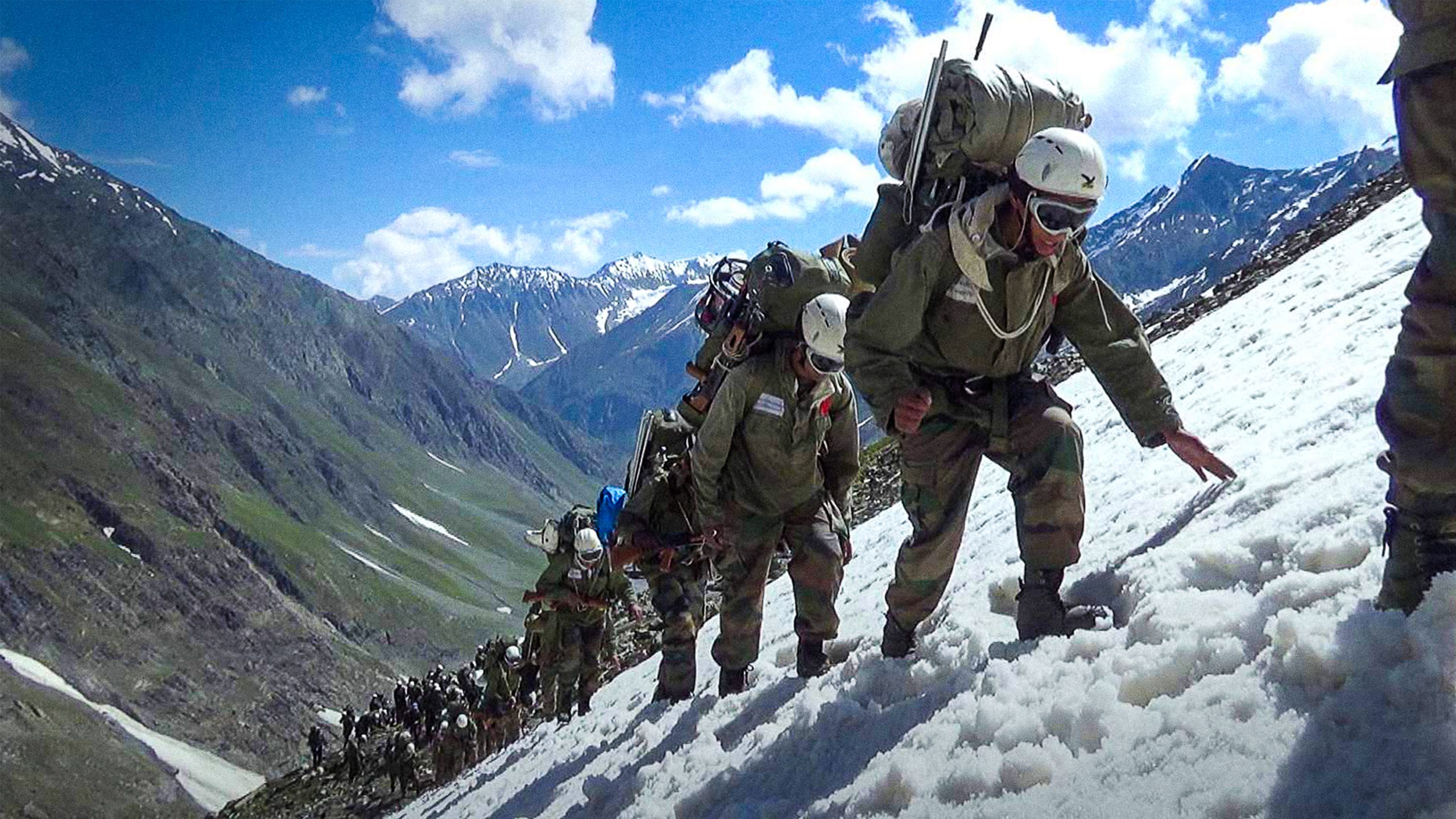If a low medical category soldier has been posted in field, modified field, CI OPS or high altitude, then is he fit to serve there ? if he is not fit, then what are the conditions to be applied on him ?
Here we have some exclusive information as per Army Order 2001 in this regard. Long Before, any soldier, JCO or officer gets posted in field, modified field, CIOPS or high altitude, a medical exam usually conducted. During the soldier’s medical examination the doctor checks employability restrictions as per Army Order 2001 and declares the soldiers fit or unfit to be posted there. After that the Jawan can go and be deployed in that place. These are determined in different categories according to different safe factors, upon which a Jawan can be posted considering the safe factors, altitude and medical category.
So, we will go through all these rules and regulations as per Army Order 2001. There are huge doubts about whether any low medical category soldiers are fit to be posted to high altitude or modified field or field or CIOPS or not. Generally you all know that whatever factor you have is known as SHAPE S means Psychological H means Hearing A means Appendages and P means Physical And E means Eyesight From the code here you will understand that your category is determined according to the code (SHAPE).
SHAPE -1 candidates only enrolled in Indian Armed Forces and undergo training of a soldier in the army/Navy/Air Force. But if any such incident happens to a soldier due to military stress and strain or any accident or any such incident during active war, then it is included in any lower medical category of any kind included in S H A P E categories. It appears to have been downgraded in the factor. Now let me explain that after SHAPE-1, if a jawan is in SHAPE-2 i.e. S-2, H-2, A-2, P-2 or E-2 category, then what are the employability restrictions as per his lower medical category?
It can be understood like this. In Column 1 you will get functional capacity and in Column 2 you will get employability restrictions but we will understand the linking of Column 1 with Column 2. Fit for normal duties anywhere i.e. wherever there is duty which is normal duty, Soldiers and officers with SHAPE-2 medical category is fit for service every where Including overseas except for actual / close combat. SHAPE-2 factor jawan are fit for any normal duty of actual war but those who have given specific relaxation may have restrictions for the following duties also.
There are restrictions for category 2 ,firstly duties involving independent post at isolated location, such a location which is isolated where one will not be able to do independent duty can not be assigned to S-2 soldiers. He will not be able to do independent duty in isolated location. Or there is no need for him to do independent duty. Patrol/ sentry duties which demand keen hearing, accuracy of both ears. Such a patrol or sentry duty should have the right ear on both the ears. They should give correct hearing. These restrictions are applicable for H-2. One should be eligible If H-2 is imposed on that person then he is unfit for that duty.
P2 soldiers are not fit for duties at altitude above 2500 meters and extreme cold areas. So first of all let us see which is such a soldier who is not fit for duties at altitude above 2500 meters and extreme cold areas. P-2 i.e. the lower limb A-2-L Which is the lower limb category, we can say that H-2 A-2 and P-2 These 3 low medical category soldiers are not deployed above the height of 2500 meters. Not fit for duties at hilly terrain, altitude above 2500 meters and extreme cold areas i.e. 2nd meaning of A-2 C A-2 lower limb and D means P-2 A-2-L and P-2 If someone has low medical category, then he is unfit for hilly terrain area or extreme cold area whose height is more than 2500 meters. E-2 – there are no restrictions for this for ordinary purpose in the fighting areas sub-shooting standard But may be called upon to fight under exceptional circumstances.
Now we will discuss about SHAPE-3. It is said that personnel whose disabilities are of a higher degree than those acceptable for category 2, can not be posted in LOC area unit/Fmn headquarters in operational areas. Provided such duties do not involve severe stress and strain. Will be placed in category 3 Such personnel must possess functional capacity under the 5 factors mentioned in here
According to the standards given in AO 2001,SHAPE-3 soldiers are fit for routine duties except santry duties under supervision in areas where hospital facilities exist nearby.
They are not fit for duties at altitude above 2500 meters. Not fit for duties involving independent responsible tasks. That is Arms store, drawing money from bank and independent command for normal duty. But not fit for sentry duty whose medical category is SHPE-3, he is unfit for sentry duty & if he does routine duty, he will also do it under supervision. There should be a hospital facility nearby But along with this, SHAPE-3 LMC soldiers cannot be deployed above 2500 meters and no such duty like Kote, drawing money from a bank or independent command.
They will not be given any such duty So this was the employability restrictions for safe 3 factor Fit for routine duties anywhere Not requiring good hearing standards Not fit for guard/sentry duties. This is applicable for H-3 LMC soldiers That is, routine duties can be done anywhere in the unit but unfit for guard /sentry duty whose low medical category is H-3, they do not apply guard duty. Now it comes to appendages i.e. A-3. It is said that the upper limb, i.e. if there is any appendage above the waist or there is any problem in the body, not fit for combat duties but fit for routine duties anywhere except in extreme cold climates.
Where there is a cold area, there is a high altitude, there is a field area Except those areas and except combat duty Normal routine duty is applicable to A-3 low medical category soldiers. Now it comes to the lower limb, i.e. A-3L Fit for sedentary duties only Not fit for duties at hilly terrain and extreme cold climates.And they can not be detailed for duty at a cold place. They are fit for only normal duties.
Now let’s talk about P-3 low medical category soldiers. They are Fit for sedentary duties in areas where hospitals with appropriate specialist facilities are available nearby. There are no restrictions for P-3 low medical category soldiers to perform normal duties. May have restrictions in employability in hilly terrain and in extreme cold climates. Here you must have understood that P-3 low medical category soldiers only apply normal duties. And they can be posted where there is a hospital nearby and specialists are available there. Along with this, they cannot be sent to hilly terrain and in extreme cold climates.
Now let’s talk about E-3 Fit for garrison duties in India. Fit for duties not requiring good visual acuity E-3 low medical category soldiers can be deployed there. Apart from this, there are complete restrictions for them. Employability restrictions for SHAPE-2 and SHAPE-3 factors soldiers SHAPE-4 and SHAPE-5 also exist, but there are very rare soldiers who get this category . Once they placed in this category, are boarded out. Now I used some terminology for you Hilly terrain denotes such areas where a person has to climb up and down the heights which is likely to aggravate or put to difficulty person with cardiac, respiratory, arthritic or such disabilities . Extreme cold climate means where temperature remains below 7 degrees for 6 months or more Like Glacier, Leh, Ladakh, Dras, etc. where temperature remains below 7 degrees for 6 months or more .
So these are called extreme cold climate areas. Now let’s talk about cold climate – Climate like then prevailing in Punjab or other areas in Western Command where an individual in category 2 or 3 should normally be able to work. Cold climate means where temperature remains below 7 degrees for 6 months or more If you are in category 2 or 3 and if you are also sent to hilly terrain, high altitude, field, CI Ops or height then what are the restrictions for you? Do you have to go there or not? Are you allowed to go there or not? Sometimes it is also seen that the soldier is sent ahead without any medical treatment and he goes there and becomes unfit, then he has to come back down.
- Pensionary Benefits for LMC JCOs OR under New Rules ER & GMO 2023Definition of invalided out of service in ER and GMO … Read more
- New Clarification on ER and GMO 2023 : Doubt ClearGovt of India, Ministry of Defence has recently updated the … Read more
- Change of DOB of Wife of Ex Servicemen in Military Documents : Detailed ProcessMismatch of DoB in Adhar card, PAN Card, Voter Card … Read more
- Keep Update Your Discharge Book : Detailed ProcedureAfter retirement, there may be many changes in your family, … Read more
- CSD AFD item Rate Chart 2024 : Car etc.Soldiers, veterans and their family members may get benefitted with … Read more
- Huge Vacancy for Exservicemen : Apply NowIt is true that most of the vacancies released in … Read more







